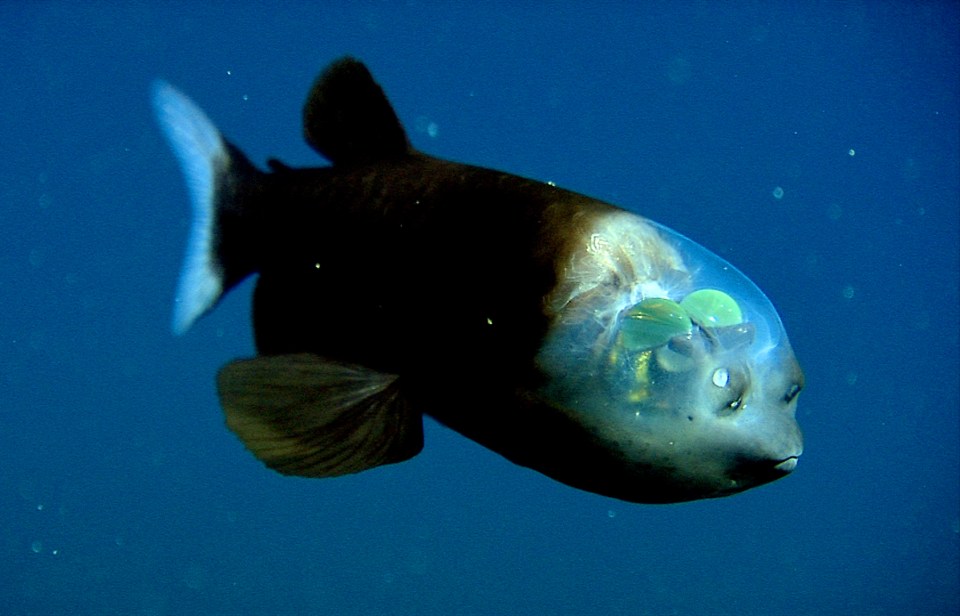Five ‘sea aliens’ caught on camera – from fish with eerie see-through head to rarely seen squid with 13ft tentacles
There are creatures that occasionally don’t seem like they belong on Earth that lurk thousands of feet below the ocean’s surface.
With the aid of more advanced underwater robots, humans are getting to know these extraterrestrial species.
Barreleye fish
This eerie animal, called a barreleye fish, inhabits the northern Pacific Ocean at depths of up to 1km (3280ft), where light seldom ever reaches.
Its eyes are the two bright green orbs that can be seen through the see-through dome on its forehead.
Researchers at the Monterey Bay Aquarium Research Institute (MBARI) captured this fish, which is among the strangest-looking in the world, on camera earlier this year.
The barreleye is an expert at robbing jellyfish of their prey because of its translucent skull and bright green eyes.
READ MORE SEA LIFE
It has tunnel vision, which allows it to focus on small details, and its tube-shaped eyes resemble miniature binoculars.
Measuring only a few centimeters in length, the barreleye is also referred to as the Macropinna microstoma.
Incredible moment rarely seen bigfin squid with 13ft tentacles is caught on camera in world’s second deepest trench
Bigfin squid
Earlier this year, an underwater camera caught the rarely seen bigfin squid and its 13-foot tentacles from 20,000 feet below the ocean’s surface.
Their lengthy tentacles, which may reach a length of 26 feet, are what make them famous.
There have only been perhaps a dozen confirmed sightings of them worldwide.
After lowering a camera to the bottom of the Tonga Trench in the South Pacific ocean, researchers discovered the horrific creature.
“We always hope to see this type of animal,” Alan Jamieson, a professor and deep-sea biologist at the University of Western Australia, who gathered the footage, said in an email sent to Live Science in late September.
“[Bigfin squid] are not something you would actively go looking for, they are a species that relies on us coming across them by accident.”
The majority of reported sightings of bigfin squid are “serendipitous filming from oil and gas activities,” according to Jamieson.
Dinner plate jellyfish
One of the most prevalent predators at the darkest depths of the ocean is the dinner plate jellyfish, or Solmissus sp.
Its appetite is really simple.
“This deep-dwelling creature is hungry for other gelatinous creatures. Salps, comb jellies, siphonophores, and jellyfish are all on the menu for Solmissus, according to an Instagram post by MBARI researchers.
“In fact, this jelly has one of the most diverse diets of all midwater animals – so far, we have seen Solmissus eating 21 different types of gelatinous prey.”
Tentacles extended, a hungry dinner plate jellyfish swims to surprise its victim.
“Forward-pointing tentacles also help the dinner plate jelly catch animals with long tentacles or skinny bodies, like raking up twigs in the lawn,” researchers at MBARI said.
Basket star
This strange-looking critter appears to have been taken from Pans Labrinth and is perched on rocks or coral.
To catch food like zooplankton, it uses its wavy arms, which can resemble fern or tree leaves.
According to MBARI experts, these branches subsequently transport food to the star’s mouth, which is located beneath its central disk.
These deep-sea animals can weigh up to 11 pounds and live up to 35 years.
Giant sea spider
This creepy crawly, also called the enormous sea spider, adheres to the deep seafloor with its eight long, spiny legs.
These organisms can be found all throughout the planet, although they lurk at depths of 2,200 to 4,000 meters (7,200 to 13,100 feet).
According to researchers at MBARI, “a giant sea spider uses an elongate, tube-like proboscis to slurp up its prey instead of spinning a delicate web of silk to trap prey.”
It eats crustaceans, hydroids, sea anemones, and jellies, among other things.
Read More on The US Sun
The spider, officially known as Colossendeis sp., is significantly larger than its cousins that walk on land, reaching a maximum length of 20 inches (51 cm).
In contrast, the largest spider on land, the Goliath birdeater, is about 13 cm long.
Note: Every piece of content is rigorously reviewed by our team of experienced writers and editors to ensure its accuracy. Our writers use credible sources and adhere to strict fact-checking protocols to verify all claims and data before publication. If an error is identified, we promptly correct it and strive for transparency in all updates, feel free to reach out to us via email. We appreciate your trust and support!















